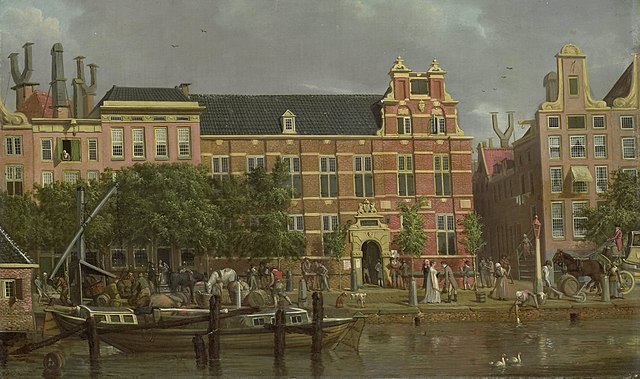“I will also take down some of the rules of the school”
On 31 Aug 1780, John Quincy Adams woke up in an unfamiliar bed.
As I recounted yesterday, the thirteen-year-old had been left at the Latin School on the Singel in Amsterdam, along with his ten-year-old brother, Charles.
Their father, John Adams, was in Holland as the Continental Congress’s representative to the Dutch government. He didn’t want his boys to fall behind on their schooling.
Earlier in the year, when the Adamses were in Paris, John had sent his two boys to a small academy. There’s no discussion in the family papers of how he made a similar decision in Amsterdam, but presumably it wasn’t a surprise.
In characteristic mode, John Quincy immediately set about to studying his new school and home. His diary for 31 August begins:
Then John Quincy wrote, “I will also take down some of the rules of the school.” At least in this recording, that really meant the meal schedule, but it ran to more than 200 words.
At the end John Quincy wrote about his fellow students:
Indeed, John Quincy then began to write out a history of the school from a 1772 French guidebook that his father had lent him, translating the prose as he went:
The new schoolboy concluded his morning diary entry by writing: “At about 10 o clock our things were brought here by [family servant Joseph] Stevens. Pappa and Mr. [Herman] Le Roi came to see us.”
John Quincy didn’t record any reluctance about staying at this school. He seems to have been really eager to fit in.
TOMORROW: The school day.
As I recounted yesterday, the thirteen-year-old had been left at the Latin School on the Singel in Amsterdam, along with his ten-year-old brother, Charles.
Their father, John Adams, was in Holland as the Continental Congress’s representative to the Dutch government. He didn’t want his boys to fall behind on their schooling.
Earlier in the year, when the Adamses were in Paris, John had sent his two boys to a small academy. There’s no discussion in the family papers of how he made a similar decision in Amsterdam, but presumably it wasn’t a surprise.
In characteristic mode, John Quincy immediately set about to studying his new school and home. His diary for 31 August begins:
This morning we got up and I asked the names of all the scholars who board here. They are as follows.He added marks to help him pronounce those unfamiliar names.
Roghe, Toelaer, Vander Burgs, Hulft, Slingelandt, Brants, Van Lennep, Koene, de Graft, Genets, Petri, Van der Paul, Clifford.
Then John Quincy wrote, “I will also take down some of the rules of the school.” At least in this recording, that really meant the meal schedule, but it ran to more than 200 words.
At the end John Quincy wrote about his fellow students:
Every one of the young Gentlemen Speak french and it is a general Custom for the Gentlemen to have their sons speak french. Their comes here every day an hundred boys to learn latin.That was helpful because he couldn’t speak Dutch, but he could read and speak French pretty well.
Indeed, John Quincy then began to write out a history of the school from a 1772 French guidebook that his father had lent him, translating the prose as he went:
This place was formerly a charity house of a Convent of Religious women. I have a book call’d le Guide D’Amsterdam in which this School is spoke of. It is in french but I will translate it as well as I can into English.That passage came to another 600 words, starting with a count’s permission for the city to found schools in 1342 and ending with new library acquisitions.
The new schoolboy concluded his morning diary entry by writing: “At about 10 o clock our things were brought here by [family servant Joseph] Stevens. Pappa and Mr. [Herman] Le Roi came to see us.”
John Quincy didn’t record any reluctance about staying at this school. He seems to have been really eager to fit in.
TOMORROW: The school day.


